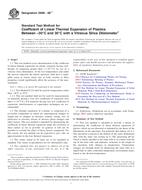Potřebujeme váš souhlas k využití jednotlivých dat, aby se vám mimo jiné mohly ukazovat informace týkající se vašich zájmů. Souhlas udělíte kliknutím na tlačítko „OK“.
ASTM D696-08e1
Standard Test Method for Coefficient of Linear Thermal Expansion of Plastics Between −30°C and 30°C with a Vitreous Silica Dilatometer (Includes all amendments And changes 4/8/2016).
Automaticky přeložený název:
Standardní zkušební metoda pro koeficient lineární tepelné roztažnosti plastů Mezi-minus, 30 ° C a 30 ° C s sklovitý Silica dilatometru
NORMA vydána dne 1.11.2008
Informace o normě:
Označení normy: ASTM D696-08e1
Poznámka: NEPLATNÁ
Datum vydání normy: 1.11.2008
Kód zboží: NS-37127
Počet stran: 5
Přibližná hmotnost: 15 g (0.03 liber)
Země: Americká technická norma
Kategorie: Technické normy ASTM
Kategorie - podobné normy:
Anotace textu normy ASTM D696-08e1 :
Keywords:
coefficient of expansion, linear expansion, plastics, thermal expansion, ICS Number Code 83.080.01 (Plastics in general)
Doplňující informace
| Significance and Use | ||||||||||||
|
The coefficient of linear thermal
expansion, α, between temperatures
T1 and T2 for a specimen whose length is
L 0 at the reference
temperature, is given by the following equation: where L1 and L2 are the specimen lengths at temperatures T1 and T2, respectively. α is, therefore, obtained by dividing the linear expansion per unit length by the change in temperature. The nature of most plastics and the construction of the dilatometer make −30 to +30°C (−22°F to +54°F) a convenient temperature range for linear thermal expansion measurements of plastics. This range covers the temperatures in which plastics are most commonly used. Where testing outside of this temperature range or when linear thermal expansion characteristics of a particular plastic are not known through this temperature range, particular attention shall be paid to the factors mentioned in 1.2 and special preliminary investigations by thermo-mechanical analysis, such as that prescribed in Practice D 4065 for the location of transition temperatures, may be required to avoid excessive error. Other ways of locating phase changes or transition temperatures using the dilatometer itself may be employed to cover the range of temperatures in question by using smaller steps than 30°C (54°F) or by observing the rate of expansion during a steady rise in temperature of the specimen. Once such a transition point has been located, a separate coefficient of expansion for a temperature range below and above the transition point shall be determined. For specification and comparison purposes, the range from −30°C to +30°C (−22°F to +86°F) (provided it is known that no transition exists in this range) shall be used. |
||||||||||||
| 1. Scope | ||||||||||||
|
1.1 This test method covers determination of the coefficient of linear thermal expansion for plastic materials having coefficients of expansion greater than 1 × 10−6/°C by use of a vitreous silica dilatometer. At the test temperatures and under the stresses imposed, the plastic materials shall have a negligible creep or elastic strain rate or both, insofar as these properties would significantly affect the accuracy of the measurements. Note 1—There is no similar or equivalent ISO standard. 1.1.1 Test Method E 228 shall be used for temperatures other than −30°C to 30°C. 1.1.2 This test method shall not be used for measurements on materials having a very low coefficient of expansion (less than 1 × 10−6/°C). For materials having very low coefficient of expansion, interferometer or capacitance techniques are recommended. 1.2 The thermal expansion of a plastic is composed of a reversible component on which are superimposed changes in length due to changes in moisture content, curing, loss of plasticizer or solvents, release of stresses, phase changes and other factors. This test method is intended for determining the coefficient of linear thermal expansion under the exclusion of these factors as far as possible. In general, it will not be possible to exclude the effect of these factors completely. For this reason, the test method can be expected to give only an approximation to the true thermal expansion. 1.3 The values stated in SI units are to be regarded as standard. The values in parentheses are for information only. 1.4 This standard does not purport to address all of the safety concerns, if any, associated with its use. It is the responsibility of the user of this standard to establish appropriate safety and health practices and determine the applicability of regulatory limitations prior to use. |
||||||||||||
| 2. Referenced Documents | ||||||||||||
|




 Cookies
Cookies
